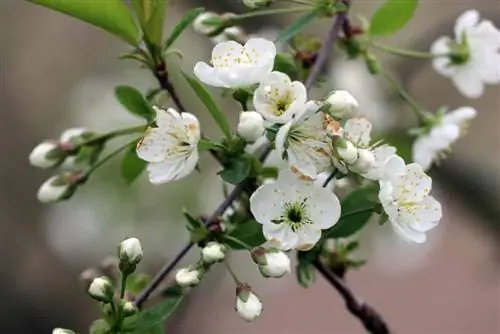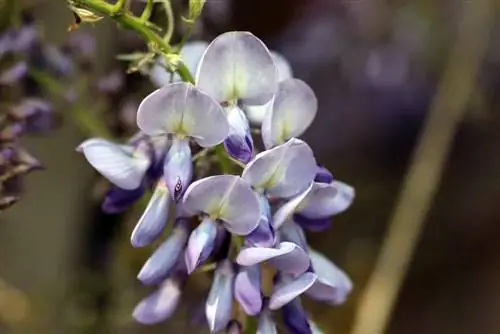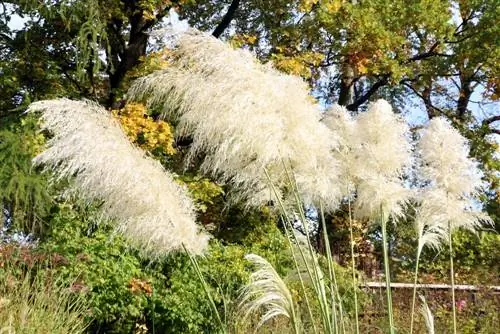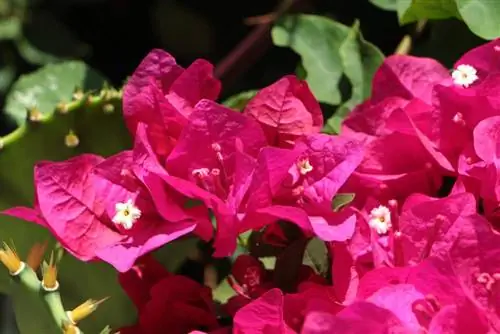- Author admin [email protected].
- Public 2023-12-17 03:39.
- Last modified 2025-01-24 12:45.
If the apple tree doesn't bloom, the harvest will of course fail. This is of course particularly annoying for hobby gardeners who have planted their trees themselves and cared for them carefully. But with the right knowledge of the possible causes and the appropriate countermeasures, a remedy can often be easily found. Even a small change in fertilization, cuttings or the design of the tree disc can help the apple tree to bloom again or even increase the harvest.
Alternance and variety
The term alternation describes the alternation of high-yield and low-yield years, which is also evident in some apple varieties. In these cases, a year with fewer or no flowers is not worrying and does not indicate care errors, but is normal.
The varieties commonly affected are:
- Delbarestivale
- Boskoop
- Noble of Leipzig
- Elstar
It is possible to influence it by removing some flowers in flowering years. This encourages the tree to produce more buds for next year.
Fruits
If the apple tree bears a lot of fruit, it is likely that it will hardly have any flowers next year. For varieties that do not form buds for the next year immediately after flowering, it helps to remove some of the fruits early.
late frost
If there is a late frost in spring or early summer, the flowers that have already opened will freeze. Of course, there is little that can be done to change the temperature, but it is possible to offer the apple tree a little protection from frost. To do this, spray with a 3 percent valerian solution in the morning and afternoon, but the leaves should not be wet. The measure is intended to mitigate the effects of night frosts of up to -3°C and protect the flowers. A wind-protected location or a garden fleece can also provide some frost protection.
Tree disc
If grass or other plants grow on the tree disc, it is possible that they compete with the apple tree for nutrients and that it then lacks the energy to form flowers. It is therefore advisable to keep the tree disc clear. However, if there are growths on it that need to be removed, you must proceed very carefully. Since the apple tree has shallow roots, the roots could be damaged and their nutrient absorption could also be impaired.
Fertilization
When it comes to fertilization, less is more when it comes to apple trees. A strong supply of nutrients, especially with regard to nitrogen, stimulates the apple tree to grow - but more shoots and leaves sprout. There is then hardly any energy left for flowers. Potassium and phosphorus fertilizers can help here. An overall cautious supply of nutrients, which only occurs from the second year onwards, also prevents flower failure due to too much nitrogen. Mature compost is also well suited, just a few liters of which are added to the tree disc and lightly worked into the surface. One gift per year is enough.
Water
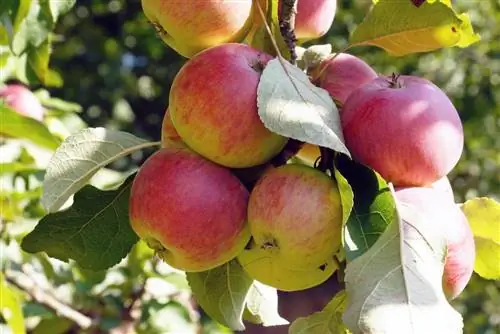
Targeted watering is necessary for apple trees after planting until they root and in dry phases. If it lacks water, bud and flower formation can be reduced. In addition, existing flower buds can dry out and fall off. Care should therefore be taken to ensure that the soil does not dry out completely. At the same time, waterlogging must also be prevented, as apple trees react sensitively to it.
Tip:
A slight depression around the tree disc helps direct the water specifically into the root area. This way, watering becomes more efficient. Covering the tree disc with bark mulch or stones also reduces evaporation and keeps the soil moist for longer.
Blend
If the apple tree is pruned too radically, too little or at the wrong time, this can have a detrimental effect on the development of the flowers. The main thing to note when cutting is that the crown should be thinned out. This allows light and air to penetrate, which is beneficial for the growth of leaves, buds and fruits.
Shoots are therefore blended that:
- cross over
- growing inwards
- growing parallel to the main trunk
- bearing no or hardly any buds
In principle, the apple tree can be pruned all year round, but autumn to spring is recommended - before new shoots occur. It should be frost-free and dry and the cutting should be done in the morning. This allows the wounds to close more quickly. It also makes sense to make the trimming gently but annually. On the one hand, this stimulates flower formation and, on the other hand, avoids the need for radical cutting. This may be necessary if the crown has grown too densely. However, flowers are also lost and the tree has to recover from the measure, which delays the formation of new buds.
Age
As an apple tree gets older, the size and number of fruits usually decrease. Flowering is also usually reduced. With a rejuvenation cut, in which disturbing shoots are specifically removed and the crown is thinned out, bud formation and yield can be increased again. There is no need to be timid when it comes to cutting to rejuvenate the apple tree. However, cuts that are larger than the circumference of a 1 euro coin should then be treated with a wound closure from a specialist retailer.
Tip:
Large branches should be sawn up to a third from the bottom and only then sawn off from above. This prevents the bark from tearing out.
Fruit ring
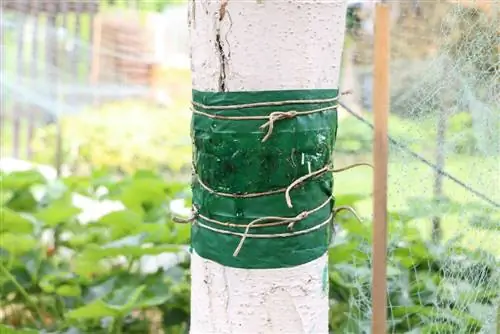
If all the measures mentioned so far do not lead to the formation of flowers and fruits, the use of a fruit ring can be considered. However, it should be noted that this:
- long-term damage to the apple tree
- the risk of breakage increases
- the risk of diseases is increased
The possible consequential damage usually only becomes apparent after one to two decades, but the tree then usually has to be felled. The fruit ring should therefore be the last resort and only used after all other options have been tested. When attaching the fruit ring, proceed as follows:
- A rubber band, a strip of foam or sheet metal are placed around the trunk.
- A thin wire is placed on this pad and pulled as tight as possible or the ends are twisted in.
- Applied in spring, around March, the fruit belt should lead to the formation of numerous flowers for the next year during the season and in this case can be removed in autumn. If increased flower formation does not occur, the fruit belt remains on the trunk until the next summer and is only then removed.
Pollination
The harvest does not always fail because there are no flowers or they have been damaged. It is also entirely possible that they simply are not fertilized. Other apple trees in the immediate area can help. Alternatively, two to four variety apple trees can be selected, which contain noble shoots from different apple tree varieties and can thus pollinate each other.
Conclusion
If the apple tree doesn't bloom, good advice is neither expensive nor requires a lot of effort. If you get to the bottom of the cause and adjust care accordingly, you can usually solve the problem quite easily. All you need is a little patience until the tree can recover and produce new flowers.

